

Swift pulls off the role beautifully he is cerebral, attempting to philosophize away his personal mistakes and reacting stoically the passionate outbreaks of his Step-Daughter. He acts as the spokesperson for the characters, contested by the Step-Daughter (played by Patricia Fernández de Castro-Sámano) and silently condemned by both the Mother (Kitty Baker) and the Son (Cameron Hart). The action of the play is dominated by the role of the Father, played by FTT major Austin Swift. This layer of improv adds yet another dimension to the already-complicated soup of reality and art. Each night, the show could be somewhat different - on opening night, the cast admonished an audience member for a phone going off. After the show, I spoke with Mary Patano, who played Mary in the “Irish Bachelor.” She said that much of how the actors reacted to the invading characters was improv or at least were created as part of the rehearsal process.

Not all of the play is entirely preconceived. When the characters first invade the scene, the producer, played by Tyrel London, protests their requests to act their own story as they remember it. The question of artifice is present from the beginning, as the audience watches the cast prepare to rehearse the finale of the “Irish Bachelor.” They are asked to practice reacting appropriately when the signs along the edge of the stage are lit up, telling the audience when to laugh, “aw” and applaud. This change pushes the already confused line between art and reality further - now the audience must balance between the story of the characters, the “reality” created by the actors on the “Irish Bachelor” and, of course, the real world referenced and assumed by the cast and crew of the “Irish Bachelor.” The entire play hinges on questioning what is real and what is art and how we differentiate between the two. The line between illusion and reality is further complicated by Vassal’s choice to move the setting of the play.

And when rebuffed, they cry out that this illusion is their only reality.

As the actors attempt to recreate the story as it was told to them, the characters protest that the illusion being created is not accurate. They take over rehearsal, demanding that their story be told, and just as the producer does in Vassal’s version, the director eventually acquiesces. In Pirandello’s original play, the six characters invade a play rehearsal for another one of Pirandello’s works. This last weekend, in an adaption written and directed by Notre Dame graduate Patrick Vassel (2007), “Six Characters” came to Notre Dame to blur further the lines that separate the two. In Luigi Pirandello’s 1921 play, “Six Characters in Search of an Author,” the dramatist challenges our understanding of the differences between art and reality.


 0 kommentar(er)
0 kommentar(er)
